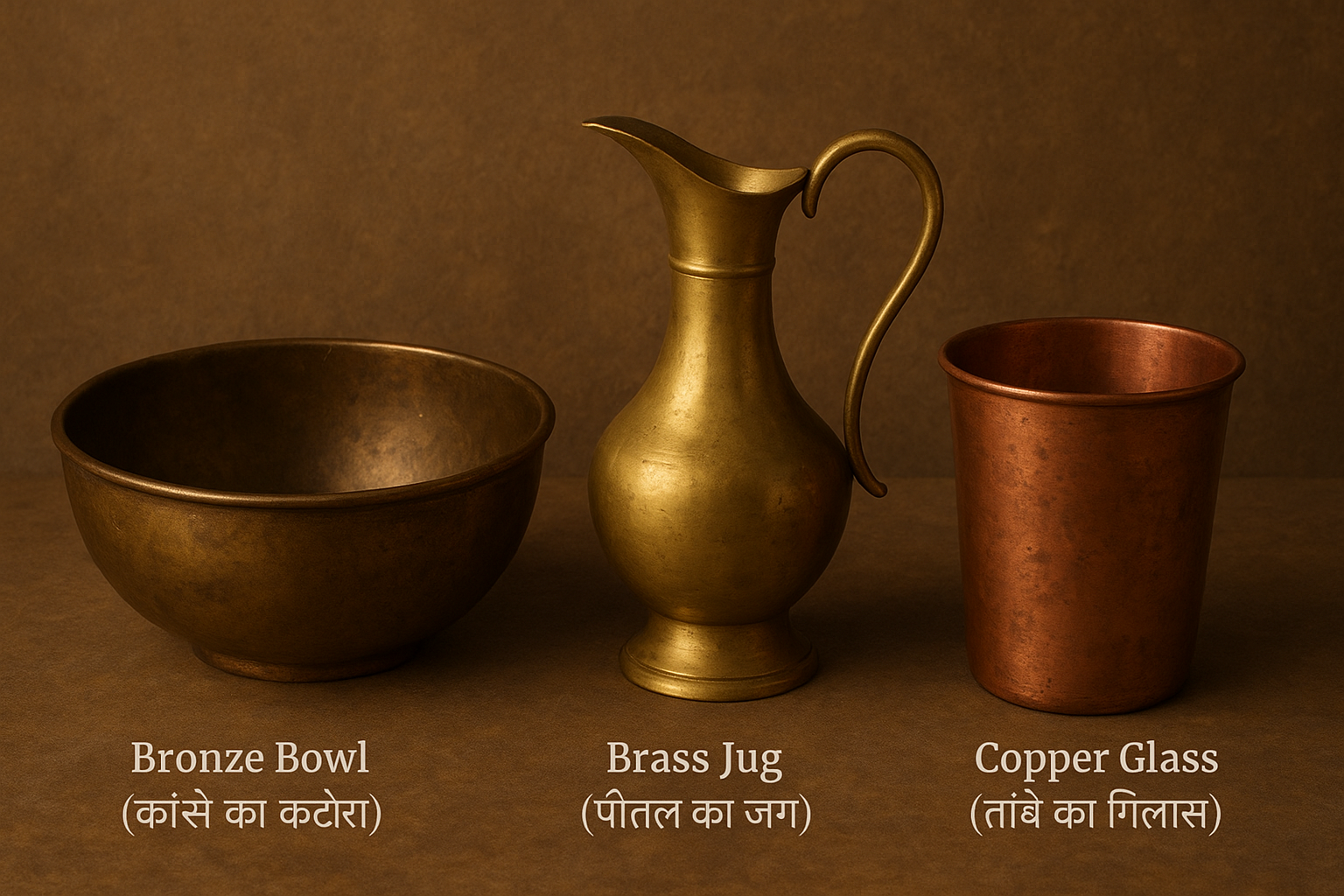Bronze (कांसा), Brass (पीतल) and Copper (तांबा)in Indian Tradition

A Comparative Overview
To summarize, here’s a table comparing the three metals:
| Metal | Composition | Key Properties | Approximate Cost (INR, 2025) | Top Health Benefits (Ayurvedic) |
|---|---|---|---|---|
| Kansa (Bronze) | Copper + Tin | Durable, alkaline, antimicrobial | Thali: 1,500-4,000 | Balances doshas, digestion, immunity, anti-inflammatory |
| Peetal (Brass) | Copper + Zinc | Malleable, corrosion-resistant | Tumbler: 400-800 | Balances doshas, digestion, immunity, and anti-inflammatory |
| Tamba (Copper) | Pure Copper | Highly conductive, antibacterial | Bottle: 500-1,500 | Skin glow, bone strength, wound healing, and reduces obesity |
Introduction
In the rich tapestry of Indian culture, metals like Kansa (bronze), Peetal (brass), and Tamba (copper) have held a revered place for centuries. Rooted deeply in Ayurveda—the ancient Indian system of medicine—these metals are not just materials for crafting utensils, cookware, and vessels but are considered vessels of health and wellness. From the bustling kitchens of rural India to the sacred rituals in temples, these metals symbolize purity, longevity, and balance. In Ayurveda, they are believed to interact with food and water, infusing them with therapeutic properties that align with the body’s doshas (Vata, Pitta, and Kapha). As modern science catches up, studies highlight their antimicrobial and anti-inflammatory qualities, making them relevant even in today’s health-conscious world.
This blog delves into the properties, costs, and health benefits of Kansa, Peetal, and Tamba, with a focus on their significance in the Indian context. Whether you’re sipping water from a Tamba jug or serving meals on a Kansa thali, these metals offer more than functionality—they promote holistic well-being. Let’s explore each one in detail.
Bronze (कांसा): The Healing Alloy of Ayurveda
Kansa, known as bronze in English, is an alloy primarily composed of copper (78-82%) and tin (18-22%). In Indian tradition, it’s often called “bell metal” due to its use in crafting temple bells and idols. Its properties make it ideal for utensils: it’s highly durable, resistant to corrosion, and an excellent conductor of heat, ensuring even cooking without hotspots. Bronze (कांसा) has a natural alkaline nature, which helps neutralize acidity in food, and its antimicrobial properties prevent bacterial growth, making it self-sanitizing to some extent. Unlike modern non-stick cookware, Bronze (कांसा) doesn’t leach harmful chemicals, aligning with sustainable Indian practices.
In terms of cost, Bronze (कांसा) utensils are premium due to the craftsmanship involved, especially in handmade pieces from artisans in regions like Uttar Pradesh and Tamil Nadu. As of 2025, a standard Bronze (कांसा) thali (plate) ranges from ₹1,500 to ₹4,000, depending on size and design. A set of bowls might cost ₹2,000-₹5,000, while larger cookware like kadais can go up to ₹10,000. Prices have risen slightly due to increasing demand for Ayurvedic products, but they remain accessible online via platforms like Amazon.
The health benefits of Bronze (कांसा) are extolled in Ayurvedic texts like the Ayurveda Prakasha, where it’s described as a “healing metal” that purifies food and balances the doshas. Eating or cooking in Kansa utensils is believed to enhance digestion by stimulating metabolism and reducing acidity—ideal for India’s spice-heavy cuisine. It boosts immunity through its antibacterial and antiviral properties, helping combat common ailments like infections. Bronze’s (कांसा) anti-inflammatory effects aid in relieving joint pain and muscular tension, beneficial for arthritis prevalent in older Indians. It also detoxifies the body, protects vision by preventing eye disorders, and promotes skin health by stimulating collagen production. In rituals, Bronze (कांसा) massagers are used for abhyanga (oil massage), calming the mind and reducing stress—a nod to its role in mental wellness. Overall, Kansa embodies Ayurveda’s holistic approach, making it a staple in eco-friendly Indian households.
Brass(पीतल): The Versatile Metal for Everyday Wellness
पीतल or brass is an alloy of copper (60-70%) and zinc (30-40%), known for its golden hue and malleability. In India, it’s widely used for pooja items, utensils, and musical instruments like ghungroos. Its properties include high corrosion resistance, good thermal conductivity, and acoustic qualities, but it’s softer than bronze, making it easier to shape into intricate designs. Brass(पीतल) has natural antimicrobial properties due to the oligodynamic effect, where trace metals kill bacteria on contact. However, it’s best for storing dry foods or non-acidic liquids, as prolonged exposure to acids can cause leaching—hence, traditional tin coating (kalai) is applied in Indian kitchens.
Cost-wise, Brass(पीतल) is more affordable than Bronze (कांसा). In 2025, a brass tumbler costs ₹400-₹800, while a full thali set might range from ₹1,000 to ₹3,000. Larger vessels like handis for cooking biryani can be ₹2,000-₹6,000. Artisanal pieces from Moradabad, Uttar Pradesh(India’s brass hub), are valued for their craftsmanship, with prices reflecting ethical sourcing.
Ayurvedically, Brass(पीतल) is praised for balancing Pitta dosha and aiding in conditions like anemia and skin diseases. Drinking water from brass vessels, known as “Pittala Jal,” enhances digestion by stimulating enzymes and reducing obesity through copper’s fat-breaking properties. It strengthens bones, regulates blood pressure, and imparts a natural glow to the skin by promoting melanin production. In Indian folklore, brass utensils are used to treat respiratory issues and boost immunity against microbes. For wound healing, its anti-inflammatory zinc content accelerates recovery, aligning with Ayurveda’s use in treating krimi (parasitic infections).In daily life, families in Rajasthan and Punjab swear by Brass(पीतल) for preserving food’s nutritional value, making it a bridge between tradition and health.
Copper (तांबा): The Essential Metal for Vitality
Copper (तांबा), pure copper, is a reddish metal renowned for its superior conductivity and ductility. In India, it’s synonymous with purity—used in temples for aarti lamps and in homes for water storage. Its key properties include exceptional antimicrobial action (killing 99% of bacteria within hours), high thermal and electrical conductivity, and malleability for crafting. Copper doesn’t rust but develops a patina, which is harmless and even beneficial.
Costs for Copper (तांबा) items are moderate: A 1-liter copper bottle in 2025 ranges from ₹500-₹1,500, while pots or jugs cost ₹1,000-₹3,000. Hammered designs from artisans in Varanasi add value, pushing prices to ₹2,000-₹5,000 for sets. With rising awareness, demand has stabilized prices despite global copper fluctuations.
In Ayurveda, Copper (तांबा) is central to “Tamra Jal” (copper-charged water), believed to balance all three doshas. Its benefits include boosting immunity by aiding white blood cell production and fighting infections—crucial in India’s tropical climate. Copper (तांबा) aids digestion, reduces inflammation for arthritis relief, and supports heart health by regulating cholesterol. It promotes weight loss, heals wounds faster, and enhances skin elasticity through collagen synthesis.Ayurvedic formulations like Tamra Bhasma treat anemia and liver issues. In Indian households, storing water overnight in copper vessels is a daily ritual for detoxification and vitality.
Conclusion: Embracing Tradition for Modern Health
In an era of plastic and stainless steel, returning to Bronze (कांसा), Brass (पीतल) and Copper (तांबा) revives India’s ancient wisdom. These metals not only enhance the flavor of traditional dishes like dal and biryani but also infuse meals with health benefits validated by Ayurveda and emerging science. While costs vary, their longevity makes them economical long-term investments. As Indians increasingly seek sustainable, chemical-free options, these metals stand as timeless allies for physical and spiritual harmony. Incorporate them mindfully—clean with tamarind or lemon to maintain their charm—and experience the transformative power of our heritage. After all, in Ayurveda, true health is about balance, and these metals help achieve just that.


